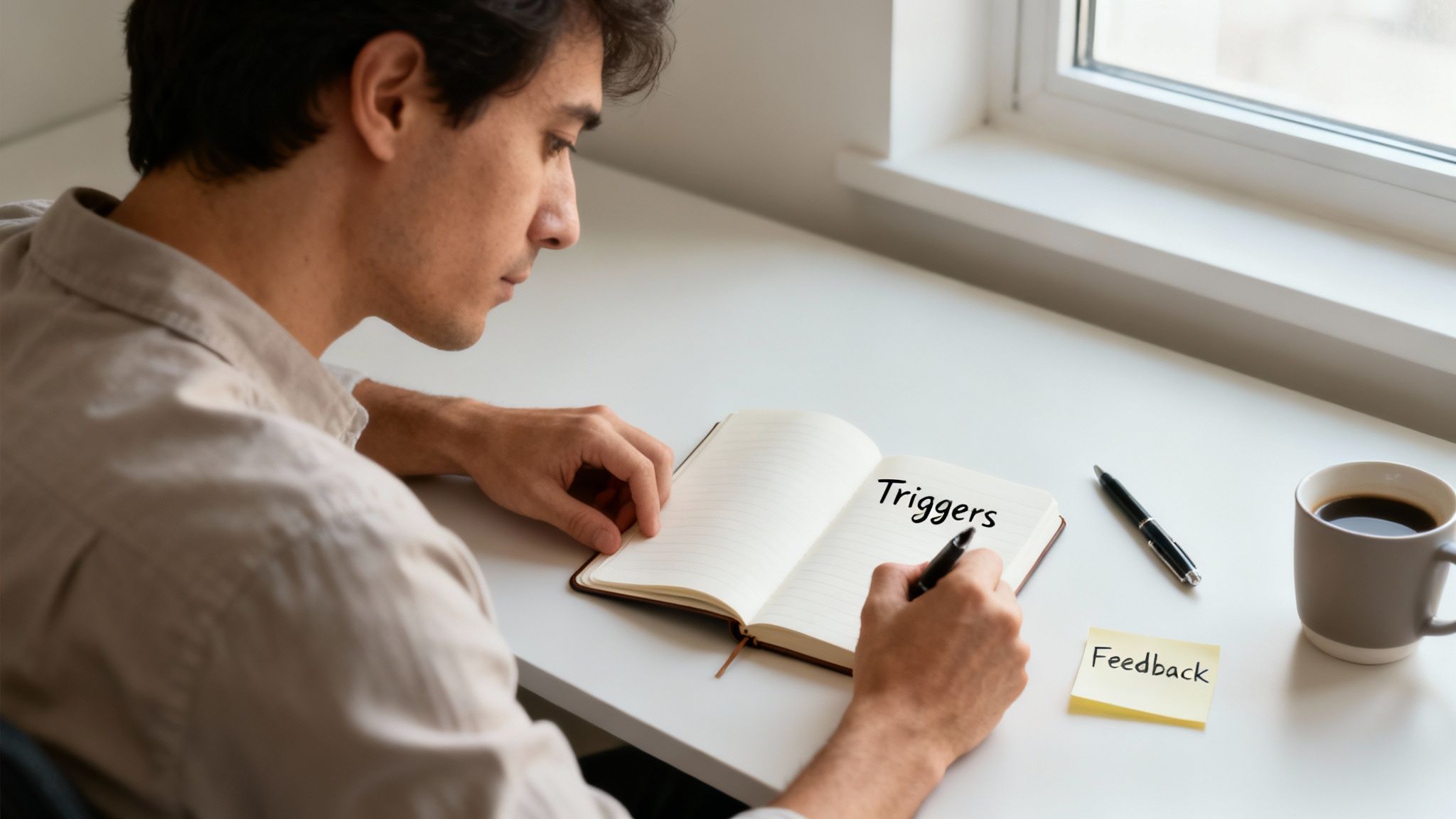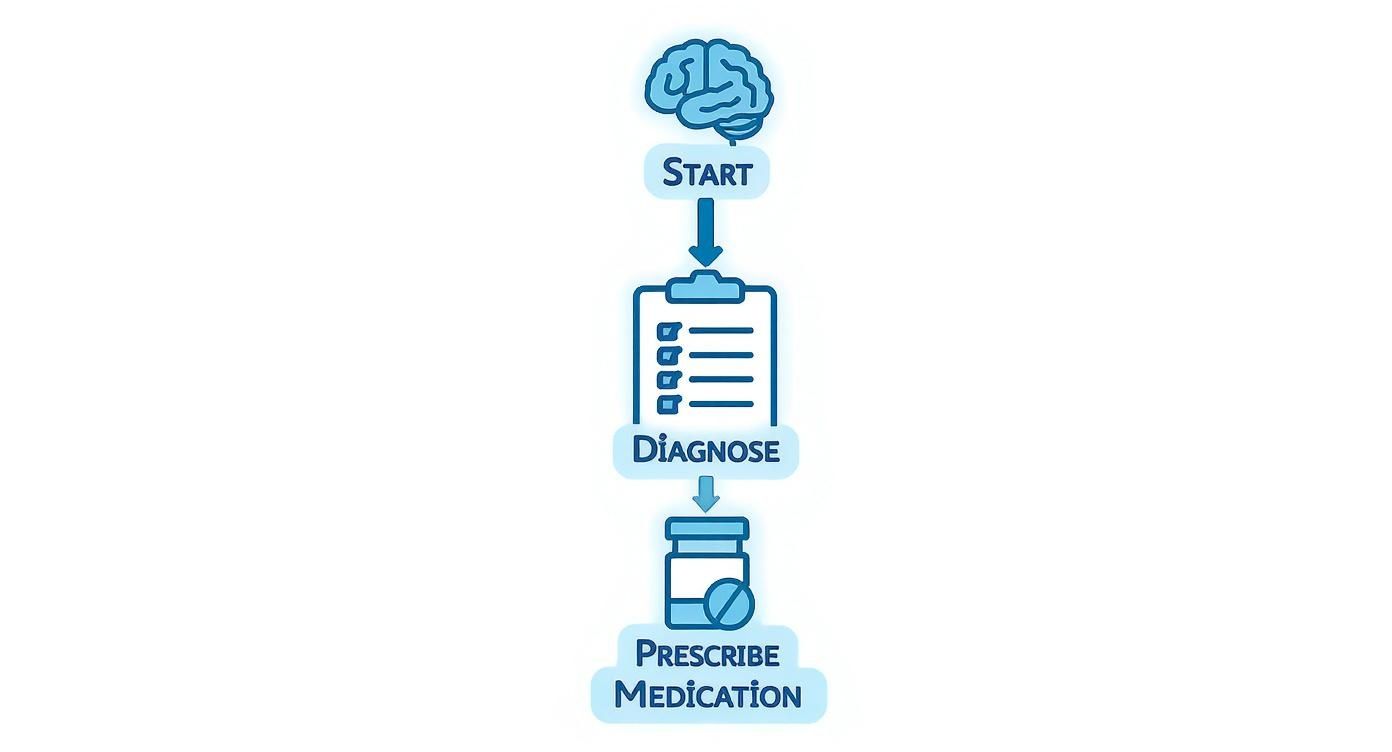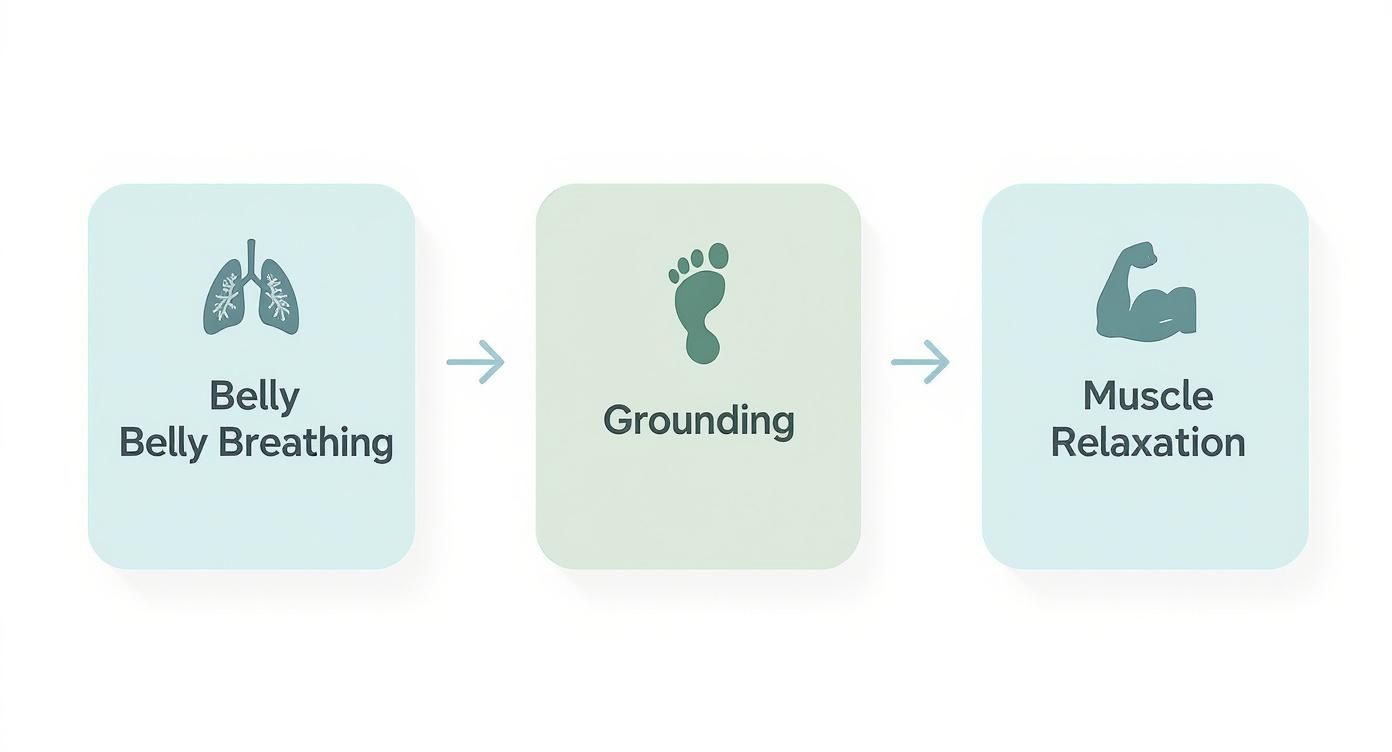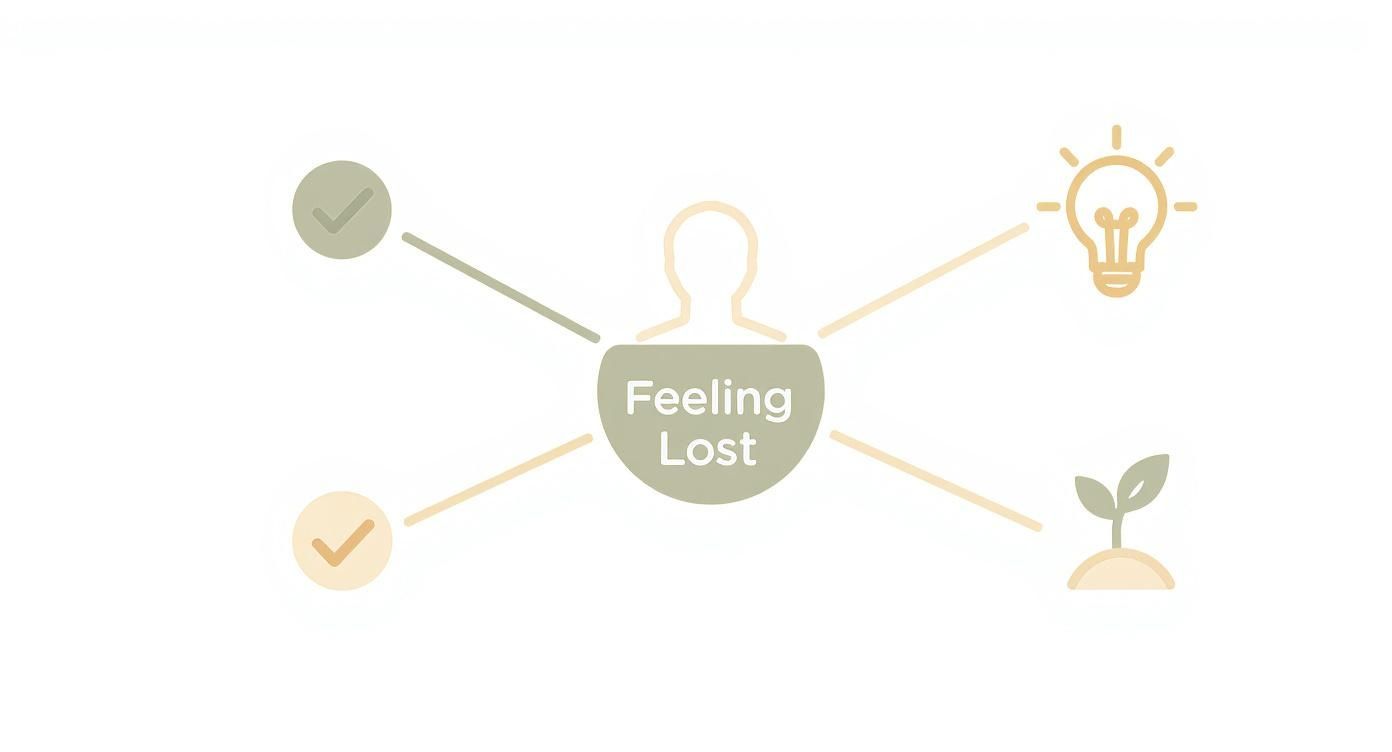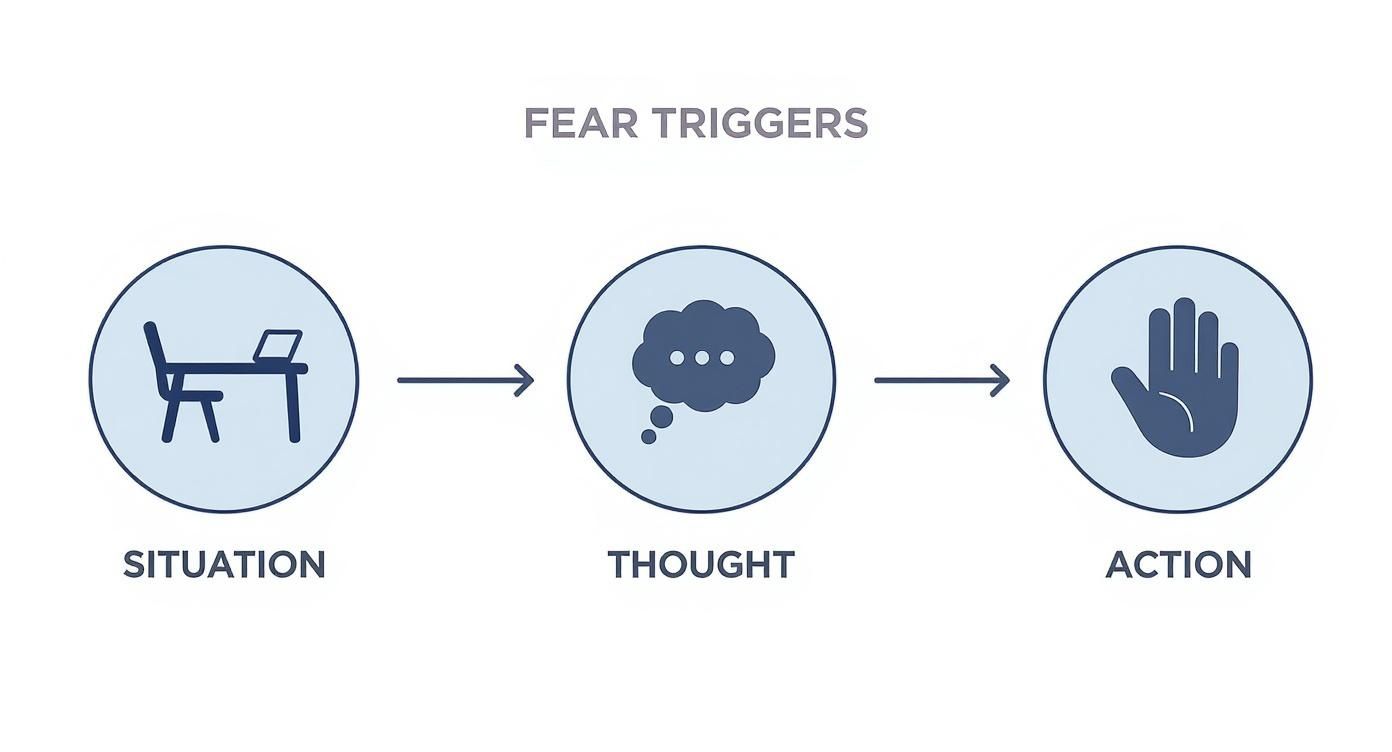Realizing your thoughts are signals, not facts, is the first step to stop overthinking your relationship. It’s about learning to gently question worst-case scenarios and return to the present moment. Opening up to your partner can replace anxious guesswork with real clarity, building the trust that quiets your mind.
Understanding Why You Overthink Your Relationship
Do you replay conversations on a loop or constantly analyse your partner’s every move? If so, you’re not alone. This mental treadmill is incredibly common, and understanding its roots is the first step toward peace.
This habit is not a character flaw; think of it as a protective instinct that's gone into overdrive. At its core, overthinking often feels like an attempt to gain control when things feel uncertain, driven by stress or anxiety.
The Connection Between Past Hurts and Present Worries
Our past relationships create a mental blueprint for what we expect from love. If you've been hurt before, trusting a new partner can feel challenging, leading you to dissect their actions for hints of dishonesty.
Similarly, if you grew up where affection felt unpredictable, you might develop an anxious attachment style. This can leave you constantly seeking reassurance, trapping you and your partner in a draining cycle of overthinking.
Overthinking is the mind's way of trying to control outcomes to avoid being hurt again. It feels like preparation but often leads to mental exhaustion, contributing to feelings of anxiety or depression.
How Cultural Pressures Can Fuel Overthinking
In India, cultural and family expectations can add another layer of complexity. The pressure to please family or follow traditional timelines can turn happy relationship milestones into sources of stress and worry.
For example, societal timelines for marriage can create a sense of urgency, causing you to overanalyse if your relationship is "the one." Seeking this external validation can disrupt the natural flow of a partnership.
This is a real issue in India, where gaps in social support can intensify relationship distress. Research from the CDC links loneliness to increased stress and depression. In an Indian context, factors like heavy family involvement can increase this pressure, making it vital to build emotional resilience.
From Self-Criticism to Self-Compassion
Recognizing these patterns isn't about blame; it’s about cultivating self-compassion. You developed these habits to protect yourself, which shows how deeply you care, even if it's causing pain now.
Acknowledging the roots of your overthinking allows you to treat yourself with kindness. This shift is fundamental for building the inner foundation needed to change these thought patterns, often with support from therapy and counselling.
How to Recognise Your Overthinking Triggers
Before you can learn how to stop overthinking your relationship, you must become a curious observer of your mind. The key is understanding what kicks off the thought spiral in the first place, spotting the spark before it becomes a wildfire of anxiety.
Often, these triggers are small, seemingly harmless moments. A vaguely worded text, a change in routine, or a social media post can activate deep-seated fears and send your mind racing.
Identifying Your Unique Triggers
Think of yourself as a detective gathering clues about your own thought patterns. The goal isn't to judge but simply to notice. Your triggers are personal but often fall into common categories.
Some of the most frequent ones include:
- Vague Communication: A short "OK" text or delayed response can feel like a sign of anger, even when it’s not.
- Changes in Routine: If your partner usually calls after work but forgets, your mind might jump to worst-case scenarios.
- Social Media Comparisons: Seeing friends' posts can trigger insecurities about your own relationship's pace or quality.
- Moments of Disconnection: A quiet evening can be misinterpreted as a red flag that the relationship is failing.
When you can name these situations, you can prepare for them. Knowing a vague text is a personal trigger allows you to pause and question the automatic negative thought instead of letting it hijack your emotions.
This infographic shows the deeper roots—like past hurts, anxiety, and fear—that often fuel our reactions to everyday triggers.
It’s a great reminder that our mind’s response is often connected to deeper emotional patterns, not just the event itself.
Spotting Unhelpful Thought Patterns
Once you've identified your triggers, the next step is to notice the mental habits they set off. These are flawed lenses that colour how you see reality, almost always leading to more anxiety and emotional burnout.
Learning to spot them is a crucial skill for improving your mental well-being, which you can develop on your own or with guidance through counselling. Let's look at some common thought patterns and how to gently challenge them.
Common Overthinking Patterns and How to Reframe Them
| Overthinking Pattern | What It Sounds Like | A Healthier Reframed Thought |
|---|---|---|
| Catastrophising | "We had a small argument. This means we’re totally incompatible and we’re going to break up." | "We disagreed, which is normal. We can talk about this when we're both calm and find a way forward." |
| Mind-Reading | "They're being quiet. They must be angry with me for what I said earlier." | "They seem quiet. I can't know what they're thinking. Maybe they're just tired from work. I'll ask them how their day was." |
| "Should" Statements | "A perfect partner should always know what I need without me having to ask." | "It's not fair to expect my partner to be a mind-reader. I need to communicate my needs clearly and kindly." |
| Black-and-White Thinking | "If we don't move in together by next year, this relationship is a complete failure." | "Relationships progress at their own pace. What matters is that we're both happy and feel secure right now." |
Becoming familiar with these patterns is incredibly empowering. It helps you see them for what they are: just thoughts, not facts.
Unfortunately, negative past experiences can make these thought patterns feel more real. In India's evolving dating scene, finding emotional security can be a real challenge. Research shows that negative relationship experiences, like cheating (42%), are a major factor in psychological distress. You can read the full research about these relationship anxiety findings to understand more.
By simply naming the pattern—"Ah, that's catastrophising again"—you create a small but powerful space between yourself and the thought. This separation gives you the power to choose how you respond instead of being swept away by the emotion.
This process of identifying triggers and patterns is the first, most important step toward building resilience. It's not about trying to eliminate worry but about learning to manage it, transforming you from a passive victim of your thoughts into an active participant in your emotional health.
Actionable Techniques to Calm Your Mind Now
When your mind races with relationship worries, you need practical, in-the-moment tools to find your footing. Think of this as your first-aid kit for an overthinking spiral—simple techniques you can use anywhere to bring peace back to your mind and body.
These strategies are about gently shifting your focus and calming your nervous system. This creates breathing room between you and the overwhelming emotions, giving you the power to respond with clarity instead of fear.

Ground Yourself with Sensory Awareness
One of the quickest ways to break a thought loop is to pull your attention into the world around you. Grounding techniques use your five senses to anchor you in the present, sending a powerful signal to your brain that you're safe right now.
A simple but effective method is the 5-4-3-2-1 technique. Wherever you are, pause and gently identify:
- 5 things you can see: Look around and name five objects. Notice their colour and shape.
- 4 things you can feel: Tune into physical sensations, like the texture of your shirt or the ground beneath your feet.
- 3 things you can hear: Listen closely for sounds you might have been ignoring, like birds chirping or your own breath.
- 2 things you can smell: Take a moment to notice any scents in the air, like coffee or fresh air.
- 1 thing you can taste: Focus on whatever taste is in your mouth, or take a sip of water.
This exercise forces your brain to switch gears from abstract worry to concrete, sensory input, which can dramatically lower the intensity of your anxiety. It’s a discreet and powerful tool you can use anytime.
Contain Your Worries with a 'Worry Time'
This might sound strange, but giving your worries a designated appointment can stop them from taking over your day. This cognitive strategy involves scheduling a limited window—say, 15 minutes each evening—to intentionally think about your relationship concerns.
When a worry appears during the day, acknowledge it and then mentally "reschedule" it. You can tell yourself, "I'll give that my full attention tonight at 6 PM," which helps you reclaim a sense of control over intrusive thoughts.
This isn’t about ignoring your feelings. It's about training your brain that you decide when to engage with anxious thoughts, building mental discipline and resilience over time.
Overthinking in relationships often connects to broader mental health challenges. This is a growing concern in India, particularly among young adults navigating anxiety and stress. A 2021 study highlighted over 5 million cases of anxiety disorders among youth in regions including India, linking the mental health burden to persistent worrying.
Untangle Your Thoughts with Journaling
Getting thoughts out of your head and onto paper is a time-tested way to reduce their power. Journaling gives you a private space to explore your fears without judgement, helping you see them more objectively.
Use specific prompts to guide your reflection, shifting from worry to problem-solving. This helps you understand the root of your feelings and build a path towards happiness.
Journaling Prompts for Relationship Anxiety:
- What is the specific fear underneath this worry? Am I afraid of being abandoned, rejected, or misunderstood?
- What’s a more compassionate or balanced way of looking at this situation?
- What evidence do I have that my fear is true? What evidence do I have that it isn't?
- If my best friend were in this situation, what would I tell them?
Journaling consistently helps you spot recurring triggers and thought patterns. To take this a step further, you can explore actionable self-discipline techniques that build mental fortitude against intrusive thoughts. These small, steady actions create lasting well-being and a quieter mind.
Building a Stronger Foundation with Communication
While managing your own thoughts is a massive step, the long-term solution to stop overthinking your relationship often comes from strengthening the connection itself. A foundation of open, honest communication and trust can naturally quiet the anxiety that fuels thought spirals.
Your partnership can shift from a source of stress to your greatest source of support and well-being. This starts when you learn to share your insecurities in a way that feels constructive, not accusatory, turning worry into connection.

Voicing Your Needs Without Blame
One of the biggest barriers to open talk is the fear of sounding needy or starting a fight. A simple and powerful technique is using "I" statements. This shift in framing lets you express your feelings without putting your partner on the defensive.
For instance, instead of, "You never text me back, it feels like you don't care," you could try a softer approach. An "I" statement reframes it: "I start to feel a bit anxious when I don't hear from you. A quick text would help me feel more secure."
See the difference? The second version invites empathy and opens the door for a conversation about how you can both feel more connected and supported, fostering compassion between you.
Starting the Conversation About Insecurity
Bringing up your insecurities takes courage and vulnerability. Choose a calm moment when you’re both relaxed and can truly listen—definitely not in the middle of a disagreement.
Here are a few gentle ways to begin:
- "I've been feeling a bit anxious about us lately, and I think it's my own stuff, but I'd love to talk it through with you."
- "Can we set aside some time to connect? Sometimes my mind runs away with worries, and just talking to you helps."
- "I sometimes create stories in my head when I'm feeling insecure. Could you help me understand what's real?"
These conversation starters create a sense of teamwork. You aren't just dropping a problem in your partner's lap; you're inviting them to help you build more resilience together.
The goal of sharing isn't just to get reassurance. It’s to build a shared understanding where both of you feel emotionally safe, which is a powerful defence against anxiety and depression.
Setting Boundaries for Mutual Security
Healthy boundaries are not walls; they are guidelines that help both of you feel respected and secure. They are crucial for protecting your mental energy and stopping the burnout that comes from constant worry.
Setting a boundary can be as simple as saying, "I need some quiet time after a long day at work to recharge." Or it could be agreeing not to have serious discussions over text, where tone is easily misread.
These mutual agreements reduce uncertainty, a massive trigger for overthinking. When you both respect each other's needs, there's far less room for anxious guesswork. For more on this, you can find great tips for building a strong relationship that focus on communication and trust.
When to Seek Professional Support
Learning to manage overthinking on your own is a huge achievement, but it's just as important to know when to ask for help. Reaching out for professional support isn't a sign of failure; it’s a proactive step toward protecting your mental well-being.
Sometimes, the thought spirals persist, affecting your daily life, your work, and the very relationship you're trying to protect. When overthinking becomes relentless, it might be tangled with deeper patterns of anxiety or even depression. You don't have to navigate it alone.
Recognising the Signs You Might Need Support
It can be tough to know the line between normal worries and something more serious. A good rule of thumb is to look at the impact on your ability to function and enjoy your day.
Here are a few signals that it might be time to talk to a professional counsellor or therapist:
- Your Anxiety Is Constant: You feel on edge most of the time, with physical symptoms like a racing heart or tight chest.
- It’s Derailing Your Life: Overthinking makes it hard to focus at work or enjoy hobbies, leading to mental burnout.
- You Feel Hopeless: The thoughts are overwhelmingly negative, and you're starting to believe things are doomed to fail.
- Your Coping Methods Are Unhealthy: You're leaning on emotional eating, drinking more, or withdrawing from others.
While online assessments from platforms like DeTalks can offer helpful insights, please remember they are for informational purposes only. They are not a substitute for a professional diagnosis from a qualified mental health expert.
How Therapy Can Help Break the Cycle
Therapy provides a safe, non-judgemental space to explore the roots of your relationship anxiety. A trained professional can help you connect past experiences to current thought patterns with an objective perspective.
A good therapist will equip you with practical, evidence-based skills to challenge unhelpful thoughts and manage your emotions. This is about building genuine, long-term resilience and learning to communicate your needs clearly.
Think of therapy as an investment in your future happiness. It empowers you with personalised tools to not only stop overthinking your relationship but also to handle future challenges like workplace stress with more confidence.
Taking That First Step
Making that initial call can feel like the hardest part, especially when you’re already overwhelmed. In India, while the conversation around mental health is improving, there can still be hesitation. Frame it as an act of self-care.
Platforms like DeTalks are designed to make this process less intimidating, helping you find qualified professionals who are the right fit. Taking this step is a powerful move away from just surviving and toward truly thriving.
Your Top Questions About Overthinking, Answered
When you're dealing with relationship anxiety, it's natural to have questions. Let's tackle some of the most common ones to provide clear, reassuring answers and reinforce the practical steps you can take.
Is It Normal to Overthink a Little in a Relationship?
Yes, a certain amount of reflection is healthy. Thinking about your relationship and your partner’s feelings helps you nurture a strong connection and handle small issues before they grow.
The trouble starts when thoughtful reflection turns into a constant, looping cycle of worry. If your thoughts cause you distress or keep you up at night, the pattern has stopped being helpful and is hurting your well-being.
Can Overthinking Actually Hurt My Relationship?
Unfortunately, it can. When you're trapped in your head, it's easy to become distant or irritable. It can also create a dynamic where you constantly seek reassurance, which can become draining for both of you.
Over time, this cycle can chip away at trust and intimacy. The good news is that you can break this cycle. By learning how to stop overthinking your relationship, you can rebuild that foundation of security.
The real damage isn't from the thoughts but from the behaviours they trigger. When you react to fears as if they're facts, you can end up pushing away the person you want to be close to, which can fuel more anxiety and depression.
How Do I Know If It’s My Intuition or Just Anxiety?
This is a great question. The difference is in the feeling. Intuition usually feels like a quiet, calm "knowing" in your gut. It brings a sense of clarity, even if the message is difficult.
Anxiety, on the other hand, is loud and chaotic. It's packed with "what if" scenarios and feels urgent and panicky. Anxiety-driven thoughts spiral, leaving you feeling more confused and exhausted, not clear. Learning to tell them apart is a massive step toward building emotional resilience.
- Intuition: Feels like a calm, deep signal. It provides clarity without an emotional storm.
- Anxiety: Feels like a noisy, frantic alarm. It creates confusion and emotional chaos.
Will I Ever Stop Overthinking Completely?
The goal isn't to silence every worry forever. The real aim is to change your relationship with your thoughts. With practice, you can learn to notice an anxious thought starting without getting swept away by it.
Think of it as building a new muscle. The more you practise grounding techniques, challenge negative thoughts, and communicate openly, the stronger your "overthinking management" muscle gets. The thoughts might still pop up, especially during times of workplace stress, but they'll have much less power over you.
This journey is about progress, not perfection. Every time you choose a healthier response, you're rewiring your brain for more peace. If the thoughts feel too big to handle on your own, remember that therapy and counselling are wonderful resources for building these skills with professional support.
At DeTalks, we believe everyone deserves to feel secure and happy in their relationships. If you're finding it hard to break free from the cycle of overthinking, our platform is here to connect you with qualified therapists and counsellors across India who can provide support and practical tools.
Ready to take the first step toward a calmer mind and a stronger connection? Explore our resources at https://detalks.com.






